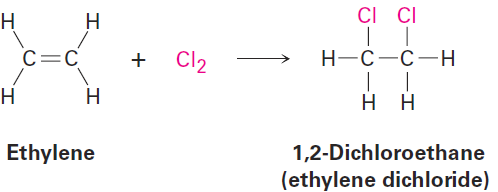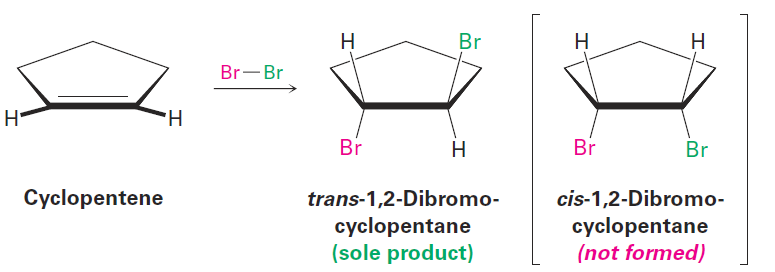


 علم الكيمياء
علم الكيمياء 
 الكيمياء التحليلية
الكيمياء التحليلية 
 الكيمياء الحياتية
الكيمياء الحياتية 
 الكيمياء العضوية
الكيمياء العضوية 
 الكيمياء الفيزيائية
الكيمياء الفيزيائية
 الكيمياء اللاعضوية
الكيمياء اللاعضوية 
 مواضيع اخرى في الكيمياء
مواضيع اخرى في الكيمياء
 الكيمياء الصناعية
الكيمياء الصناعية |
Read More
Date: 21-7-2016
Date: 28-1-2022
Date: 20-1-2020
|
Halogenation of Alkenes: Addition of X2
Bromine and chlorine add rapidly to alkenes to yield 1,2-dihalides, a process called halogenation. For example, more than 25 million tons of 1,2-dichloroethane (ethylene dichloride) are synthesized worldwide each year, much of it by addition of Cl2 to ethylene. The product is used both as a solvent and as starting material for the manufacture of poly(vinyl chloride), PVC. Fluorine is too reactive and difficult to control for most laboratory applications, and iodine does not react with most alkenes.

Based on what we’ve seen thus far, a possible mechanism for the reaction of bromine with alkenes might involve electrophilic addition of Br- to the alkene, giving a carbocation intermediate that could undergo further reaction with Br+ to yield the dibromo addition product.

Although this mechanism seems plausible, it’s not fully consistent with known facts. In particular, it doesn’t explain the stereochemistry of the addition reaction. That is, the mechanism doesn’t tell which product stereoisomer is formed.
When the halogenation reaction is carried out on a cycloalkene, such as cyclopentene, only the trans stereoisomer of the dihalide addition product is formed, rather than the mixture of cis and trans isomers that might have been expected if a planar carbocation intermediate were involved. We say that the reaction occurs with anti stereochemistry, meaning that the two bromine atoms come from opposite faces of the double bond—one from the top face and one from the bottom face.

An explanation for the observed stereochemistry of addition was suggested in 1937 by George Kimball and Irving Roberts, who proposed that the reaction intermediate is not a carbocation but is instead a bromonium ion, R2Br+, formed by electrophilic addition of Br- to the alkene. (Similarly, a chloronium ion contains a positively charged, divalent chlorine, R2Cl+.) The bromonium ion is formed in a single step by interaction of the alkene with Br2 and the simultaneous loss of Br-.

How does the formation of a bromonium ion account for the observed anti stereochemistry of addition to cyclopentene? If a bromonium ion is formed as an intermediate, we can imagine that the large bromine atom might “shield” one side of the molecule. Reaction with Br- ion in the second step could then occur only from the opposite, unshielded side to give trans product.

The bromonium ion postulate, made more than 75 years ago to explain the stereochemistry of halogen addition to alkenes, is a remarkable example of deductive logic in chemistry. Arguing from experimental results, chemists were able to make a hypothesis about the intimate mechanistic details of alkene electrophilic reactions. Subsequently, strong evidence supporting the mechanism came from the work of George Olah, who prepared and studied stable solutions of cyclic bromonium ions in liquid SO2. There’s no question that bromonium ions exist.

Alkene halogenation reactions occur in nature just as they do in the laboratory but are limited primarily to marine organisms living in halide-rich environments. These biological halogenation reactions are carried out by enzymes called haloperoxidases, which use H2O2 to oxidize Br- or Cl- ions to a biological equivalent of Br+ or Cl+. Electrophilic addition to the double bond of a substrate molecule then yields a bromonium or chloronium ion intermediate just as in the laboratory, and reaction with another halide ion completes the process. Halomon, for example, an anticancer pentahalide isolated from red alga, is thought to arise by a route that involves twofold addition of BrC+ through the corresponding bromonium ions.




|
|
|
|
التوتر والسرطان.. علماء يحذرون من "صلة خطيرة"
|
|
|
|
|
|
|
مرآة السيارة: مدى دقة عكسها للصورة الصحيحة
|
|
|
|
|
|
|
نحو شراكة وطنية متكاملة.. الأمين العام للعتبة الحسينية يبحث مع وكيل وزارة الخارجية آفاق التعاون المؤسسي
|
|
|